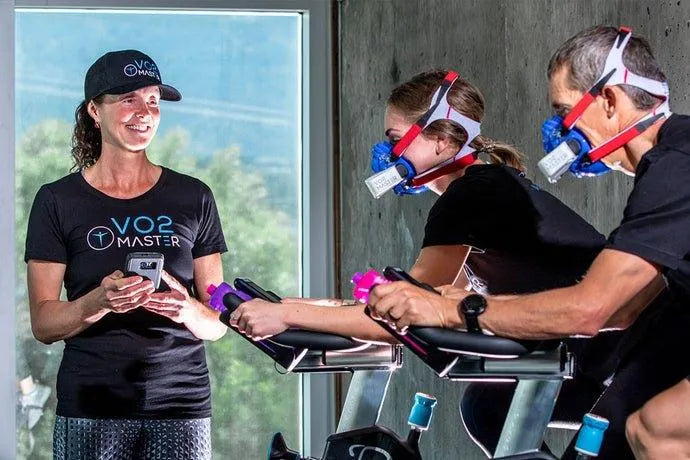Our goal is to help any sports enthusiast reach the best version of themselves. Using data from your muscles is a good place to start, but there is more that drives your performance! We are happy to announce Train.Red has teamed up with VO2Master to help athletes in their constant search for performance improvement. We believe technology and data can make a difference.
Data provides insight but it needs to be understandable and easy to use to be beneficial for the athletes and coaches. This is where an integrated setup with synchronized data becomes relevant. One interface that allows you to connect your VO2Master as well as your Train.Red device. In this blog, we will introduce VO2Master and explain the synergy between the two modalities.
VO2 and oxygen consumption improvement?
The term VO2 is more and more known and used by athletes all over the world. But for those new to the metric, we’ll start with the basics. The ‘V’ is derived from Volume and the ‘O2’ from Oxygen. The volume of oxygen consumed by the body. In contrast to NIRS, a VO2 measurement is not a local indicator, it shows how hard your entire body is working.
You can measure all of the oxygen your body consumes by placing a gas mask over your mouth and nose because this is the only place where you can inhale and exhale oxygen. The amount of oxygen you consume is typically expressed in the number of milliliters of oxygen per kilogram body weight per minute.
The easiest way to determine whether your physiologic performance has improved when looking at VO2 is the maximum amount of oxygen consumption. Your maximum oxygen consumption can be determined during an incremental exercise test. When the load goes up, your body works harder. And at a certain point, you simply will not be able to consume more oxygen. If you repeat this same test several weeks later and you can consume more oxygen, your VO2max has increased and you are physically in better shape.
Another way to know that your body has gained fitness is by measuring the time you can perform work at a given percentage of your VO2max. If you can run for 1 hour at 75% of your VO2max and weeks later for 1,5 hours, you can be sure you’re on the right track.
The components of VO2
Improving our VO2max, or maintaining a certain intensity for a longer time, does not mean we are going to do a lot of slow base work. Aerobic training has a great impact on your heart and lungs, but if you want your body to become more efficient, there is more that needs our attention:
our muscles.
Adolf Eugen Fick (1829-1901) was the first to come up with a theoretical approach to our VO2. The difference in oxygen content between the arterial and venous blood times the cardiac output will equal the oxygen consumption.
This is known as the ‘Fick principle’
The volume of oxygen (VO2) = the Cardiac Output (CO) * oxygen content of the arterial blood (Ca) - the Cardiac Output (CO) * oxygen content of the venous blood
VO2 = (CO * Ca)- (CO * Cv)
or
VO2 = CO *(a-v)O2
The arterial oxygen concentration is directly linked to the efficiency of your lungs – the ability to transfer oxygen from the air to your blood. The venous concentration shows the efficiency of your body to utilize the oxygen from the blood and transfer it to your tissue.
A muscle needs energy to contract, you’re breaking down ATP into ADP. You can read more about this in our introductory blog. The most efficient pathways require oxygen for the metabolism of ATP. That means that during activity, you will need more oxygen.
Based on the Fick principle we know our body can cope with this by increasing the heart rate or extracting more of the already available oxygen from our arterial blood.
Improve your muscle performance
If our muscle needs less oxygen for the same output, we have improved the functionality or efficiency. The venous concentration of oxygen will be higher which means that at the same heart rate, we will consume less oxygen.
Our VO2 max will be lower if our muscles function better.
If you know how hard specific parts of your body are working, you will gain a lot of insight into the amount of oxygen your body needs.
This is where local monitoring of the Train.Red sensors and the global monitoring of the VO2master strengthen each other.

This is VO2 Master
VO2 Master democratizes human performance and metabolism information to everyone’s benefit. For the better part of a century, labs and research facilities have had access to: VO2 analysis, which is the gold standard in the assessment of athletes’ performance, and diet planning through weight management. With VO2 Master, this valuable information is now accessible by everyone. Gone are the days of guesswork in prescribing training plans, tracking recovery, and balancing the caloric throughput.
With happy customers on every continent, including the likes of Nike, Trek, Adidas, and many national federations, coaching businesses, and fitness centers, VO2 Master is realizing its vision as the new standard in VO2 analysis. Looking forward, VO2 Master is just getting started. There is so much great progress yet to be made. For example: to make athletes faster, weight loss safer, and people more active.
Data makes a difference. We believe you do not need to be a scientist to benefit from your own body’s potential. But data synchronization can be a burdensome process. Especially when every wearable has its own smartphone application.
This is where the VO2 Master Manager application comes into play.
The Train.Red sensor is fully integrated and supported in this app if you’re already working with this
software, simply add the sensor in the device tile and configure the screen as you prefer.
Let’s get technical
The mobile app from VO2 Master supports multiple sensors. Besides their VO2 data and the muscle oxygenation data from the Train.Red sensor it is possible to connect multiple heart rate monitors, cycling and running power meters, speed or cadence sensors, and GPS data. All easily connected, displayed in real-time, and exported to a PDF report or raw CSV file with the trends and time interval of your choosing.
There are currently two metrics from Train.Red supported by the VO2 Master Manager application.
TSI and HbDiff, the Tissue Saturation Index, and the Hemoglobin Difference.
Learn more about the technical side of our sensors in this blog.

From the lab to the field
Since the oxygen uptake by your body is highly dependent on the amount of oxygen your muscles consume, there is naturally a clear correlation between the two parameters.
This is visible during an incremental exercise test as Guido Vroemen explains. Guido is a medical doctor, exercise physiologist, high-performance coach, but most of all enthusiastic about all of the above. With his scientific knowledge and practical know-how, he can clearly distinguish similar trends and patterns in the combined VO2 – muscle oxygen data.
A clear example in which the synergy between the two technologies showed, was during an incremental exercise test from one of Guido’s MTB athletes at the Sports Medical Advice center in Amersfoort. During the incremental step from 330 to 360 Watts the TSI trend from the Train.Red FYER sensor showed a desaturating trend. The need for oxygen becomes bigger because the muscles can not cope with the lactate that has been building up anymore. The anaerobic metabolism leaves a steady state and the oxygen trend in your TSI graph will go from sustainable to desaturating. This breaking point was actually established in real-time by Guido based on the VO2 data, keeping a close eye on the ventilatory equivalents and VO2 he could predict when to adjust the protocol of this ramp test.
Not only slow and steady?
Doing more miles will help, but it is not the only way to improve your performance. Speed and tempo sessions will help with making your muscle more efficient. As we learned in this blog, when your muscle is more efficient, your VO2 will be decreased at the same power output.
We are excited to kickstart the collaboration between VO2 Master and Train.Red and believe the integration of the two sensors can help you or your athletes to the next level.



